General
Understanding Cognitive Dissonance Marketing: A Complete Tutorial for Effective Brand Strategies
Overview
Cognitive dissonance marketing is pivotal for effective brand strategies, as it addresses the psychological discomfort consumers face when their beliefs clash with their purchasing decisions. Understanding and managing this dissonance not only enhances customer loyalty but also boosts satisfaction. Research supports this assertion, indicating that aligning marketing messages with consumer values can significantly mitigate buyer’s remorse and foster deeper brand connections. By leveraging these insights, Brand Managers can create strategies that resonate with their audience, ultimately driving brand success.
Introduction
In the intricate world of consumer behavior, cognitive dissonance emerges as a powerful psychological force that shapes purchasing decisions and brand loyalty. This phenomenon occurs when individuals grapple with conflicting beliefs and attitudes, creating a tension that can profoundly influence their buying choices. For marketers, understanding the nuances of cognitive dissonance is not just beneficial; it is essential for crafting effective strategies that resonate with consumers’ values and alleviate their internal conflicts.
From addressing buyer’s remorse to leveraging advertising techniques, brands that adeptly navigate this psychological landscape can foster stronger connections with their audiences, ultimately leading to enhanced loyalty and satisfaction in an ever-evolving marketplace. As the landscape of marketing continues to shift, the implications of cognitive dissonance will remain at the forefront, guiding brands toward more informed and ethical practices in their consumer engagements.
Defining Cognitive Dissonance: The Psychological Underpinning of Consumer Behavior
Cognitive conflict represents the psychological discomfort that emerges when an individual simultaneously holds conflicting beliefs, values, or attitudes. This phenomenon generates significant tension, prompting individuals to seek harmony between their beliefs and behaviors. For marketers, understanding cognitive dissonance marketing is essential, as it directly influences buying choices and customer loyalty.
Consider an individual who values sustainability. This person may experience dissonance when contemplating a purchase from a company notorious for environmentally harmful practices. Such internal conflict can foster negative feelings toward the company, potentially undermining loyalty. By recognizing these psychological insights, marketers can craft targeted messaging that resonates with consumers’ values, guiding them toward more favorable purchasing decisions.
Recent research has illuminated the relationship between product loyalty and mental discomfort, significantly influencing customer complaint behavior. Specifically, while customer loyalty positively correlates with mental conflict, it does not directly affect complaint behavior, with a negative effect quantified as β = -0.052, p > 0.05. This insight is crucial for luxury product marketers, who must adeptly navigate the complexities of buyer psychology to enhance satisfaction and loyalty.
Case studies, such as “Structural Equation Modeling of Brand Loyalty and Complaint Behavior,” exemplify the intricate relationships at play. This research utilized structural equation modeling to investigate the connections between brand loyalty, mental discomfort, and complaint behavior. It reveals that while loyalty positively influences mental discomfort, it lacks a direct significant impact on complaint behavior. These findings underscore the importance of addressing psychological conflict in cognitive dissonance marketing strategies; companies that effectively manage this mental strain can cultivate stronger relationships with their clients.
As we look toward 2025, the implications of mental conflict continue to evolve. Companies are increasingly recognizing the necessity of integrating cognitive dissonance marketing into their strategies. By crafting messages that align with customer values and addressing potential conflicts, brands can bolster loyalty and drive purchasing decisions, ultimately leading to more successful marketing outcomes. As Y.P. noted, “Informed consent was acquired from all participants involved in the study,” underscoring the ethical considerations inherent in market research related to cognitive conflict.
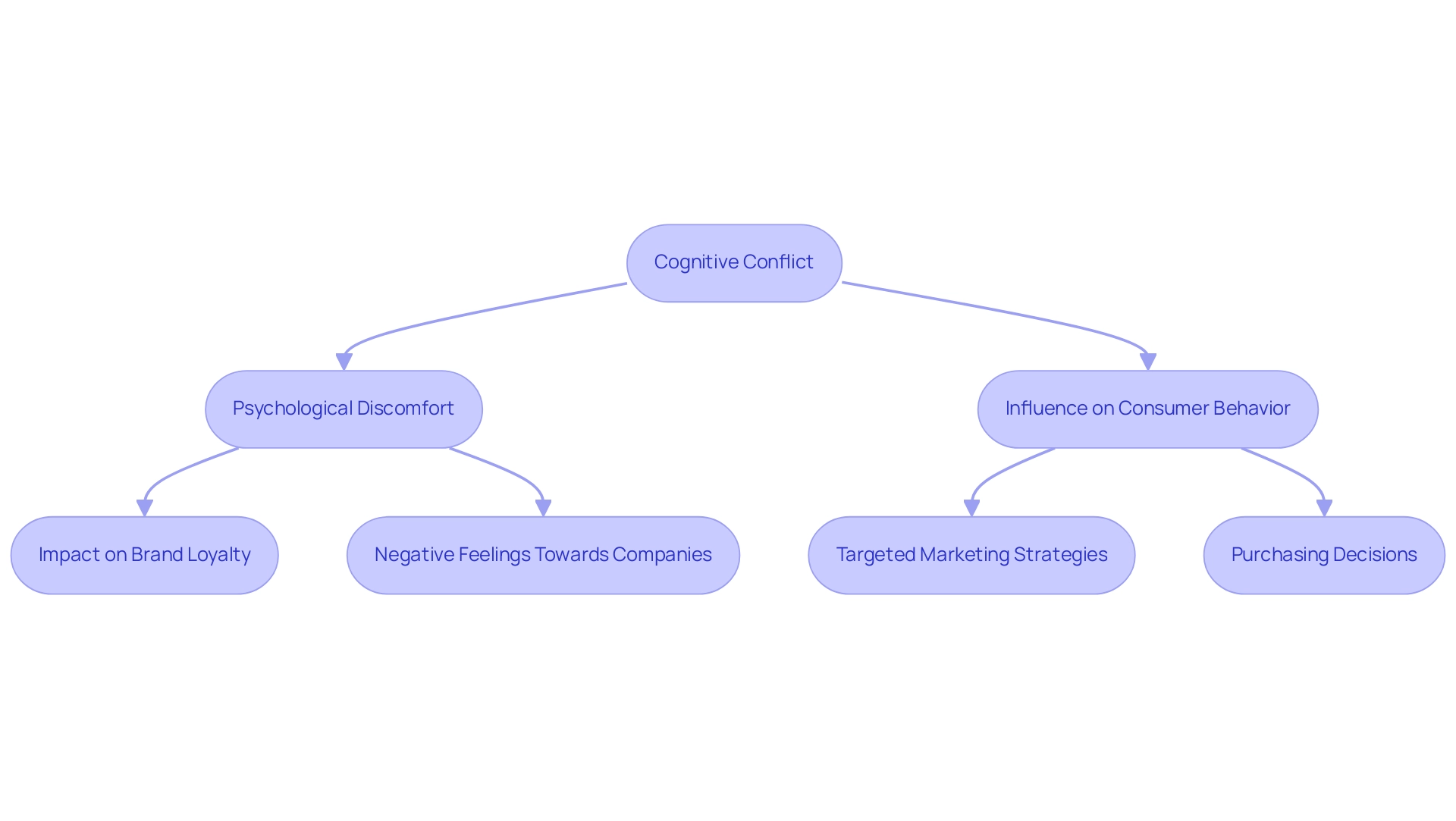
The Impact of Cognitive Dissonance on Purchasing Decisions: Insights for Marketers
Cognitive dissonance marketing is pivotal in influencing purchasing decisions, often leading to buyer’s remorse or hesitation. This psychological phenomenon arises when individuals grapple with conflicting thoughts regarding their purchases, resulting in second-guessing and negative sentiments towards the brand. For instance, a consumer who invests in a high-priced item may later encounter a more affordable alternative, evoking feelings of regret and dissatisfaction.
Statistics reveal that nearly 80% of shoppers prioritize proximity to stores when considering their ‘dream home,’ underscoring a significant connection between purchasing decisions and emotional responses. This correlation emphasizes the necessity of addressing buyer’s remorse within cognitive dissonance marketing strategies. Marketers can effectively mitigate confusion by reinforcing the value of purchases through targeted follow-up communications, highlighting product benefits, and providing reassurances that validate the buyer’s choice.
Expert insights indicate that leveraging anticipated regret can empower consumers to cultivate healthier shopping habits, ultimately curbing impulsive buying behavior. Arianna Huffington, Founder and CEO of Thrive Global, articulates, “Often decisions around what we buy and buying things that we can’t afford are so associated with our sense of identity and what we feel we need in order to function in our lives.” This statement accentuates the emotional gravity of purchasing decisions and the critical need to address buyer’s remorse.
Retailers are urged to assist customers in circumventing buyer’s remorse by offering comprehensive product details, establishing clear expectations, and implementing flexible return policies. These strategies not only aid in diminishing mental conflict but also enhance customer satisfaction.
Case studies further illustrate the impact of mental conflict on buying behavior. A study employing a 2×2 ANOVA demonstrated that low product involvement coupled with downward anticipated regret significantly heightened online impulsive buying behavior. This finding underscores the relationship between product engagement and buyer emotions, reinforcing the imperative for companies to grasp these dynamics.
By comprehending how psychological conflict influences buyer’s regret, companies can deploy cognitive dissonance marketing strategies that not only alleviate conflict but also bolster customer satisfaction and loyalty. Implementing these strategies is essential for fostering a positive experience that resonates with customers and encourages repeat purchases.
Leveraging Advertising to Alleviate Cognitive Dissonance: Strategies for Success
Advertising serves as a pivotal tool in alleviating cognitive dissonance marketing by reinforcing positive brand perceptions. Marketers can implement a variety of strategies, including the use of testimonials, guarantees, and clear messaging, to provide reassurance to clients. For instance, leveraging customer testimonials can effectively showcase satisfaction and positive experiences, thereby diminishing any lingering doubts potential buyers may have.
Furthermore, post-purchase advertisements play a crucial role by reminding individuals of the benefits associated with their decisions, which helps to reinforce their choices and mitigate feelings of regret.
By strategically tackling psychological conflict through cognitive dissonance marketing, brands can foster deeper connections with their customers, ultimately enhancing brand loyalty. The effectiveness of these strategies is underscored by statistics indicating that consumers actively seek out social proof, which significantly boosts engagement. For example, Social Proofy offers a 14-day free trial for its services, highlighting the relevance of social proof in marketing strategies.
In 2025, cognitive dissonance marketing through testimonials and guarantees remains essential, as they not only reduce mental conflict but also foster trust, making them crucial elements of effective advertising campaigns.
As Eric H. Shaw noted, “Marketing has been practiced since ancient times and has been thought about almost as long. Yet, it is only during the 20th century that marketing ideas evolved into an academic discipline in its own right.” This historical perspective underscores the evolution of marketing practices, including the strategic use of testimonials and guarantees.
Furthermore, a study on psychological processes in social media usage shows how addressing conflicting beliefs can boost user engagement on contemporary platforms, further demonstrating the significance of these advertising strategies.
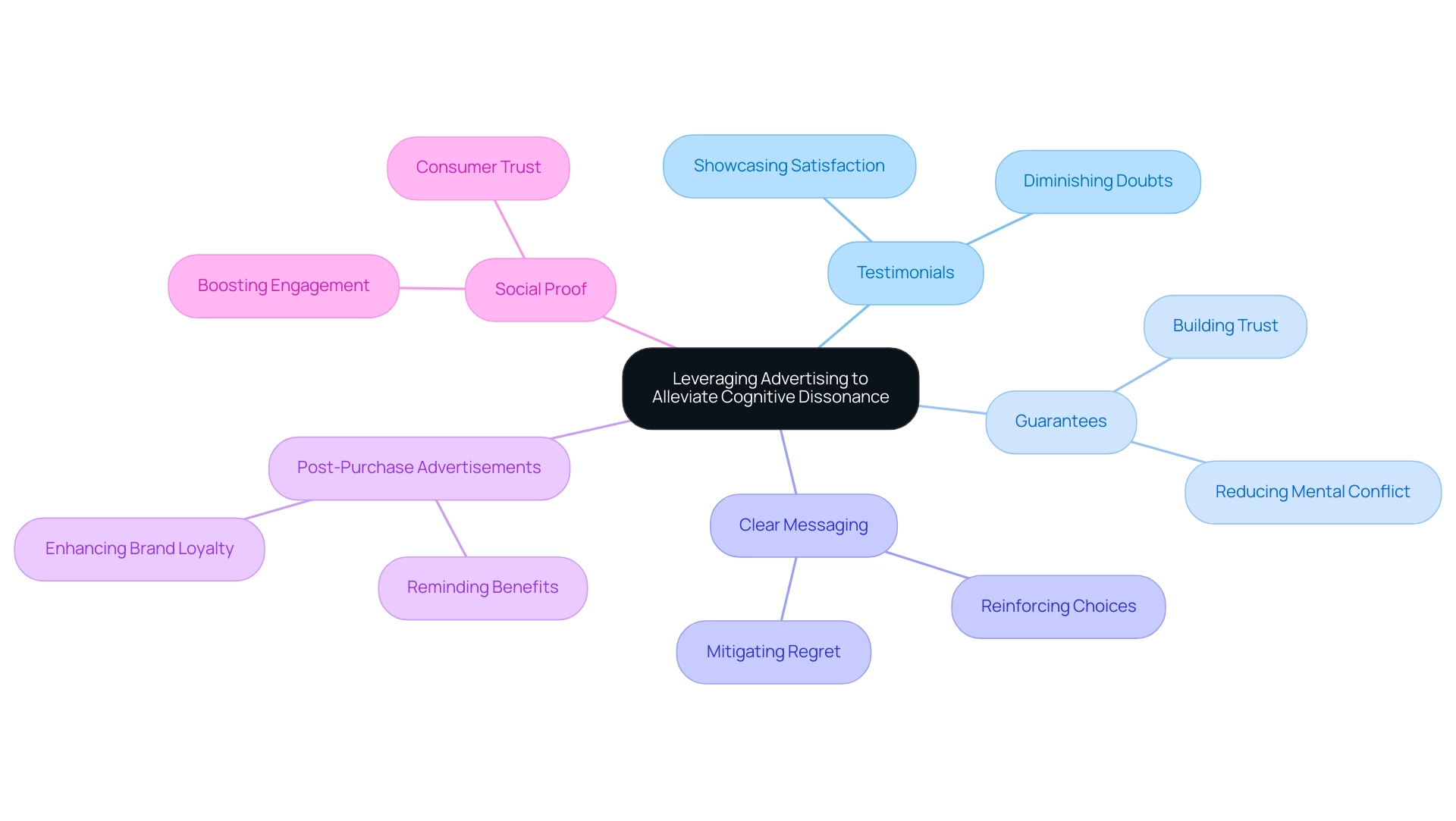
Understanding Your Audience: Tailoring Marketing Strategies to Minimize Dissonance
To effectively minimize cognitive dissonance in marketing, marketers must cultivate a profound understanding of their target audience’s values, beliefs, and preferences. This understanding enables companies to customize their messaging and product offerings to align with customer expectations. For instance, companies targeting environmentally aware individuals should prominently highlight their sustainable practices and materials in promotional efforts.
By aligning marketing strategies with audience values, companies can significantly reduce the likelihood of cognitive dissonance, fostering positive experiences and enhancing customer loyalty.
Interacting with clients through surveys and feedback systems is crucial for enhancing this understanding. This allows companies to adjust and improve their marketing strategies consistently. Notably, statistics indicate that 54% of shoppers define loyalty to a brand as a positive mindset and connection that encourages repeat purchases. This underscores the necessity of aligning messaging with buyer values. As Blake Morgan, a customer experience futurist, states, “Every client interaction is an opportunity to gain new customers and drive positive business outcomes,” highlighting the critical nature of understanding the target audience.
Case studies, such as the comprehensive campaign for Quaker Oats, illustrate the effectiveness of this approach. WonderEight’s strategy revitalized the brand’s image and enhanced customer engagement, demonstrating how a well-aligned marketing approach can lead to measurable outcomes. Furthermore, WonderEight has effectively executed creative branding solutions for multiple clients, showcasing its proficiency in tackling conflicting perceptions through customized marketing strategies.
As businesses are progressively encouraged to develop microtargeting skills, comprehending particular microsegments becomes essential for effective interaction and reducing mental conflict in 2025 and beyond.
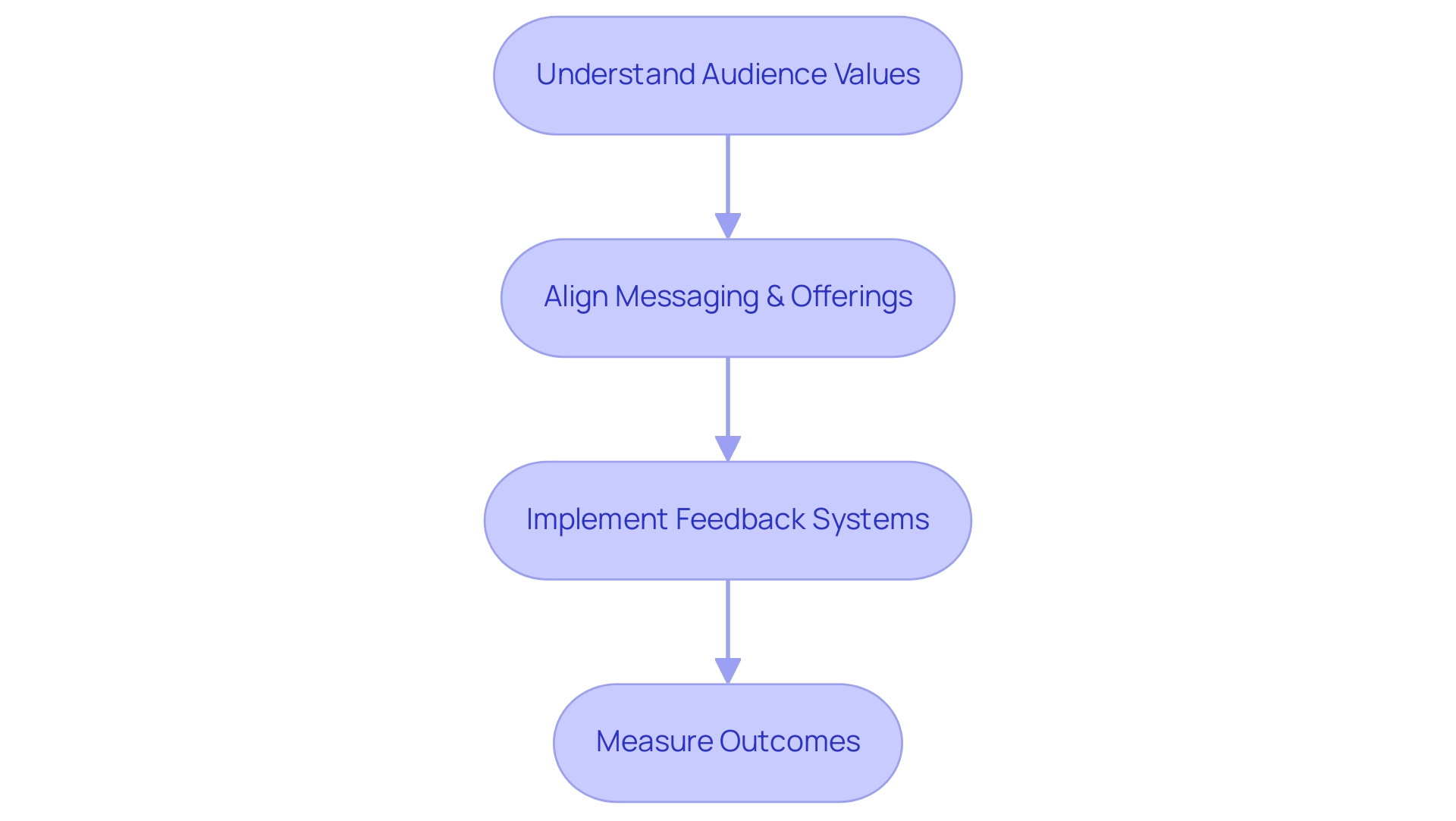
Ethical Considerations in Cognitive Dissonance Marketing: Balancing Persuasion and Integrity
Leveraging cognitive dissonance marketing can yield significant results; however, marketers must navigate the associated ethical considerations with care. Tactics that manipulate consumer vulnerabilities risk eroding trust and tarnishing company reputation. Therefore, companies should prioritize transparency and authenticity in their messaging.
For instance, if a company claims its product is eco-friendly, it must ensure that its operational practices genuinely align with this assertion.
Recent statistics reveal that 65% of consumers are more likely to trust companies that demonstrate transparency in their marketing efforts. This trust is crucial, as it fosters loyalty and can lead to sustainable business success. Notably, Dove’s Real Beauty Campaign has successfully evolved to address issues of digital distortion, contributing to a remarkable 65% increase in value since its launch.
In 2025, ethical marketing trends emphasize accountability for partners’ practices and the importance of hyper-personalization ethics. As Sherry Frey, vice president of total wellness at NielsenIQ, states, “They can achieve both simultaneously by employing a thoughtful, fact-based, consumer-centric ESG strategy.” Brands that maintain integrity while utilizing cognitive dissonance marketing can effectively balance persuasion with ethical considerations.
For instance, WonderEight’s extensive identity and digital marketing solutions, including audits, social media management, and innovative design and technology, illustrate how to improve customer engagement while maintaining values. This approach not only strengthens market position but also reinforces consumer trust.
WonderEight has successfully implemented these strategies for various clients, leading to significant improvements in perception and customer loyalty. Ultimately, by adopting a thoughtful, consumer-centric strategy that emphasizes ethical practices, companies can achieve both persuasive marketing and integrity, ensuring long-term health and success in the competitive landscape.
Case Studies: Successful Branding Strategies Utilizing Cognitive Dissonance
Many companies have skillfully utilized cognitive dissonance marketing in their strategies to cultivate stronger connections with buyers. Apple exemplifies this approach by positioning its products as premium and innovative, creating a sense of dissonance among buyers. This encourages them to justify their purchases through heightened loyalty to the brand and a strong perception of value.
For instance, a notable 43.7% of users prefer Apple as their smartphone choice, demonstrating the effectiveness of this strategy in boosting engagement. As noted by Florina Oana Virlanuta, “The Effect of Cognitive Dissonance Theory and Brand Loyalty on Customer Complaint Behaviors” highlights the intricate relationship between these concepts, emphasizing how cognitive dissonance marketing can influence buyer behavior.
Similarly, Nike challenges individuals’ perceptions of athleticism and performance, motivating them to connect their self-image with the company’s empowering messaging. This strategy not only fosters a sense of belonging but also strengthens loyalty, as individuals feel compelled to align their aspirations with Nike’s identity. The case study titled “Impact of Brand Loyalty on Mental Conflict and Complaint Behavior” further illustrates this relationship, particularly among mobile phone users, showing that higher brand loyalty may lead to increased mental conflict and varied complaint behaviors.
These case studies underscore the significance of effectively managing conflicting beliefs using cognitive dissonance marketing to enhance customer engagement and loyalty. Additionally, a March 2016 study modeled the effects of alternative products on consumers’ e-service switching behavior, revealing that alternative attractiveness can negatively affect perceived service quality and satisfaction while positively impacting switching intention and behavior. Marketers can extract important insights from these instances, developing strategies that resonate with their target audiences by leveraging the psychological subtleties of conflicting beliefs.
By understanding how companies like Apple and Nike navigate these dynamics, marketers can craft compelling narratives that not only attract but also retain customers in an increasingly competitive landscape.
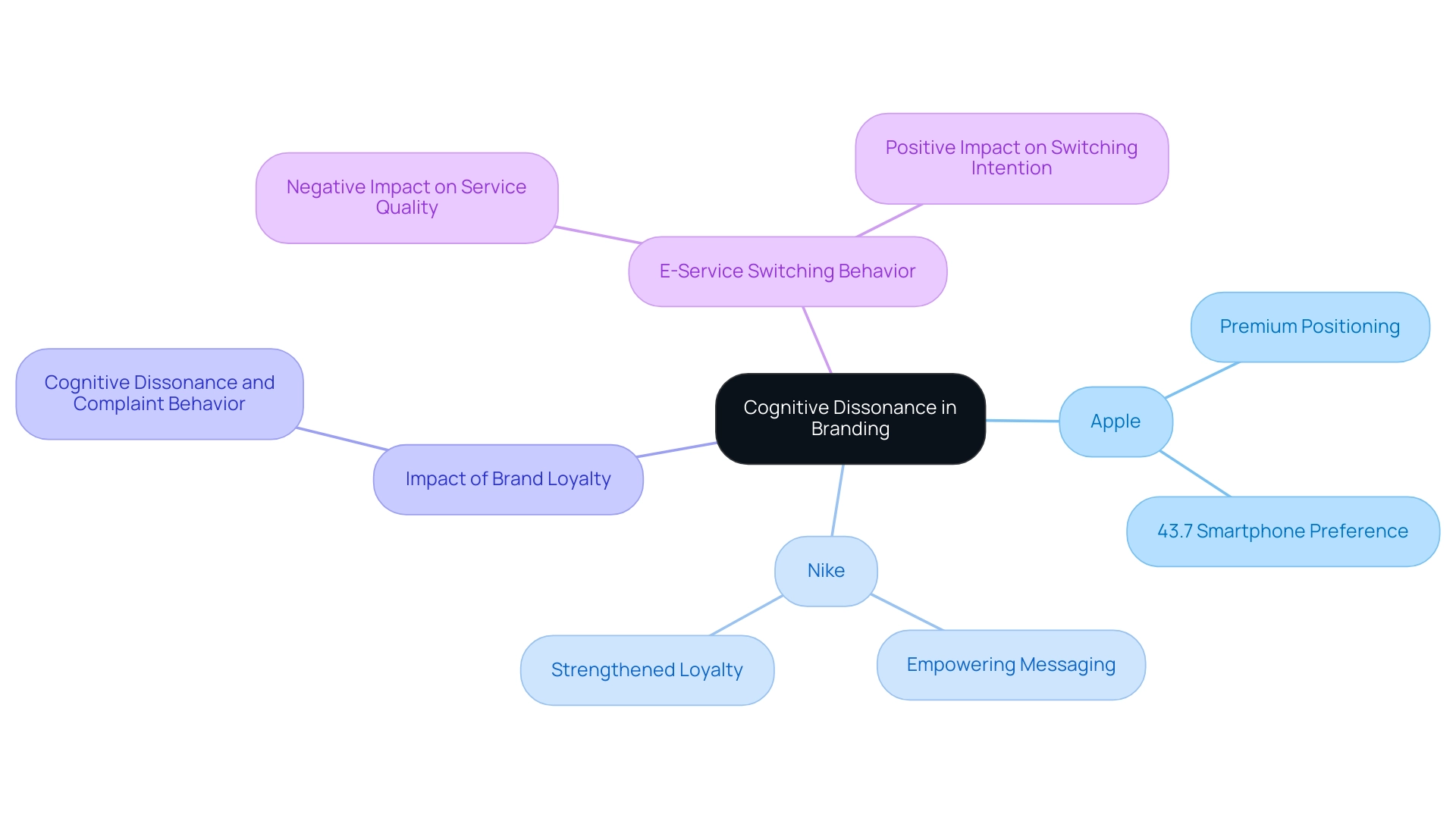
The Future of Cognitive Dissonance in Marketing: Trends and Innovations to Watch
As marketing evolves, the concept of cognitive dissonance marketing is increasingly pivotal in influencing buyer behavior. Customized marketing—tailoring messages to individual data—emerges as a powerful strategy to mitigate conflict by aligning communications with audience values and preferences. This approach not only enhances relevance but also fosters a deeper connection between the brand and the customer.
Moreover, the rise of social media influencers presents companies with unique opportunities to address cognitive conflict through authentic endorsements. Influencers bridge the gap between expectations and messaging, thereby reducing feelings of dissonance that may stem from conflicting information or experiences. By harnessing the trust and relatability of influencers, brands can craft a more cohesive narrative that resonates with their target audience.
As highlighted by Hongjie Sun, “To optimize the effectiveness of AI-generated ads, companies should strike a balance between the perceived utility and perceived threat that personalization brings to individuals.” This underscores the importance of grasping buyer psychology within the realm of personalized marketing.
Additionally, a case study titled “Cognitive Dissonance Marketing Strategies for Users” outlines effective tactics for addressing cognitive dissonance among users of pan-entertainment mobile live broadcast platforms. Implementing these strategies can empower users, enhance their experience, and potentially decrease the likelihood of discontinuous usage intentions, ultimately boosting overall user satisfaction.
Insights from Esat Artug further illustrate the vital role of personalization and digital experience in shaping user interactions. Marketers must remain vigilant in monitoring these trends and adapting their strategies accordingly. Embracing innovation and staying attuned to consumer psychology will enable companies to elevate their marketing effectiveness.
Looking ahead to 2025, the integration of personalized marketing strategies and influencer partnerships is poised to play a crucial role in shaping future trends, particularly in cognitive dissonance marketing. This evolution will foster deeper connections with audiences and drive brand loyalty.
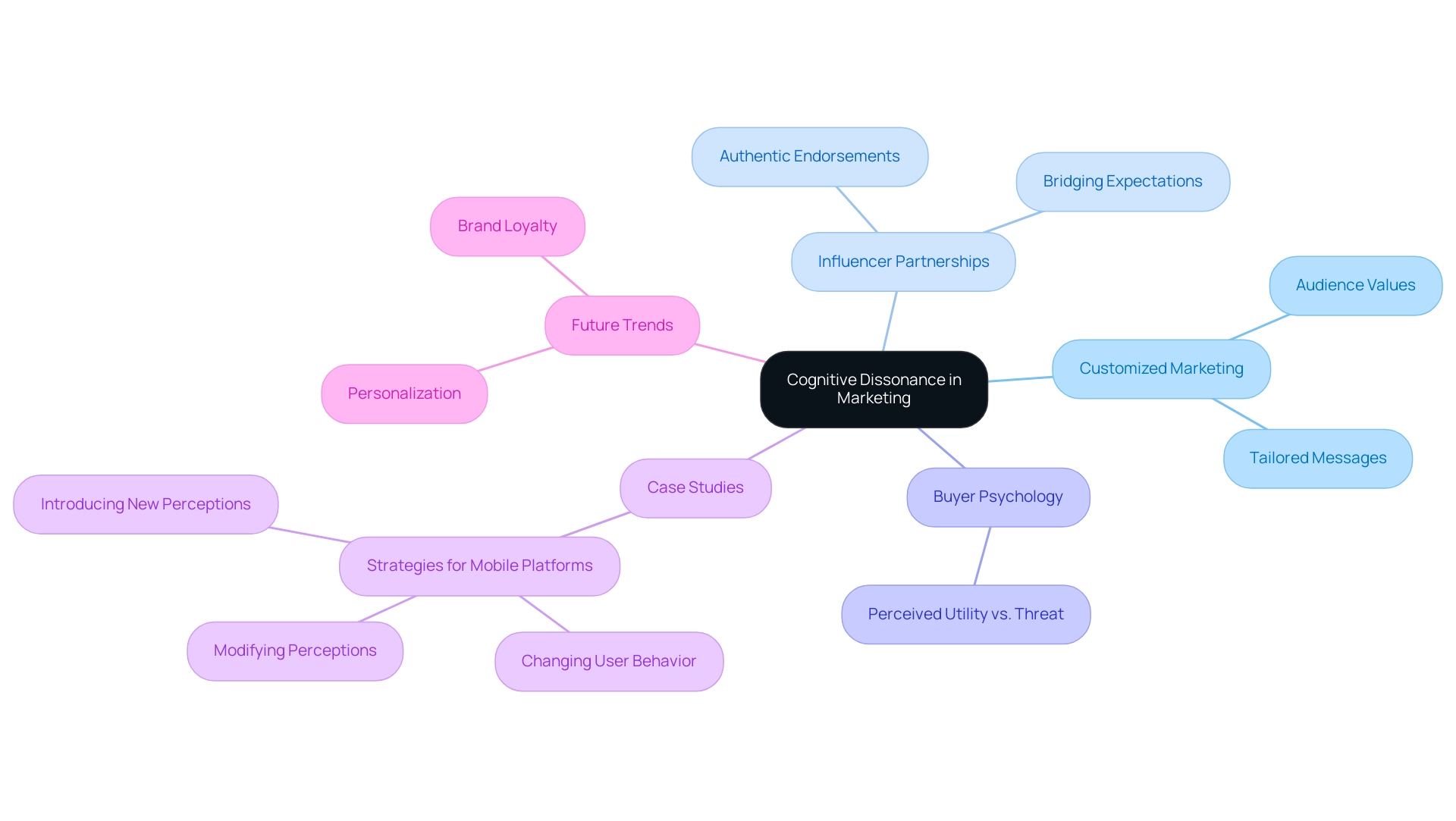
Conclusion
Cognitive dissonance serves as a pivotal element in comprehending consumer behavior and its significant influence on purchasing decisions. This psychological phenomenon not only shapes consumer perceptions of brands but also impacts their loyalty and satisfaction. By acknowledging the internal conflicts consumers encounter, marketers can devise strategies that resonate with their audiences—be it through targeted messaging, leveraging testimonials, or emphasizing ethical practices.
The insights presented underscore that addressing cognitive dissonance transcends mere marketing tactics; it is an essential practice for cultivating trust and loyalty. Brands that recognize and alleviate buyer’s remorse, engage authentically with their audience, and uphold transparency will forge stronger connections with consumers. As evidenced by case studies of successful brands like Apple and Nike, adeptly navigating this psychological landscape enables marketers to foster brand loyalty and enhance customer satisfaction.
Looking forward, the significance of cognitive dissonance in marketing is poised to escalate. As trends gravitate towards personalization and authentic influencer partnerships, brands must adapt their strategies to align with consumer values and expectations. By prioritizing ethical considerations and grasping the emotional weight of purchasing decisions, marketers can craft compelling narratives that not only attract customers but also ensure their retention in an increasingly competitive market. Embracing these principles will be crucial for driving success and nurturing enduring relationships with consumers in the future.
Frequently Asked Questions
What is cognitive dissonance?
Cognitive dissonance is the psychological discomfort that arises when an individual holds conflicting beliefs, values, or attitudes, leading to tension as they seek harmony between their beliefs and behaviors.
How does cognitive dissonance impact marketing?
Understanding cognitive dissonance is crucial for marketers as it influences buying choices and customer loyalty. Marketers can create targeted messaging that aligns with consumers’ values to guide them toward favorable purchasing decisions.
Can you provide an example of cognitive dissonance in consumer behavior?
An example is a consumer who values sustainability but considers purchasing from a company known for environmentally harmful practices. This internal conflict can lead to negative feelings toward the company, affecting loyalty.
What does recent research say about the relationship between product loyalty and mental discomfort?
Research indicates that while customer loyalty is positively correlated with mental conflict, it does not significantly affect complaint behavior. This insight is particularly important for luxury product marketers.
What is the significance of the case study on brand loyalty and complaint behavior?
The case study used structural equation modeling to explore the connections between brand loyalty, mental discomfort, and complaint behavior, showing that loyalty influences mental discomfort but does not have a direct significant impact on complaint behavior.
How can companies address cognitive dissonance in their marketing strategies?
Companies can address cognitive dissonance by crafting messages that resonate with customer values and addressing potential conflicts, ultimately enhancing customer loyalty and driving purchasing decisions.
What is buyer’s remorse and how does it relate to cognitive dissonance?
Buyer’s remorse is the regret or hesitation a consumer feels after making a purchase, often due to conflicting thoughts about the decision. It is a direct result of cognitive dissonance and can negatively affect brand perception.
What strategies can marketers use to mitigate buyer’s remorse?
Marketers can mitigate buyer’s remorse by reinforcing the value of purchases through follow-up communications, highlighting product benefits, and providing reassurances that validate the buyer’s choice.
How can anticipated regret influence consumer behavior?
Anticipated regret can help consumers develop healthier shopping habits by curbing impulsive buying behavior, as it emphasizes the emotional weight of purchasing decisions.
What role do flexible return policies play in reducing buyer’s remorse?
Flexible return policies can help customers feel more secure in their purchases, reducing mental conflict and enhancing overall customer satisfaction.



